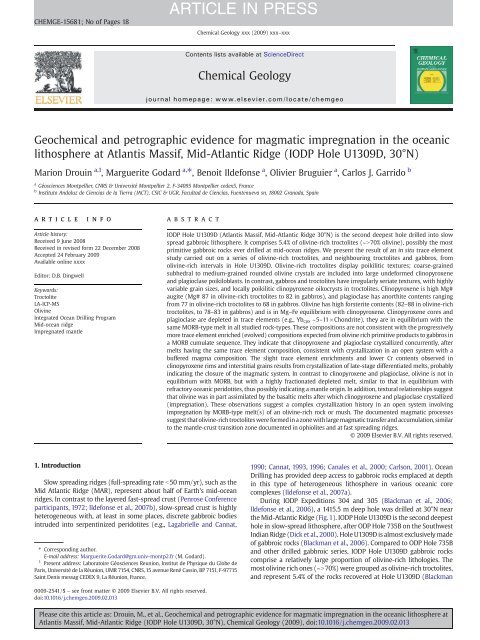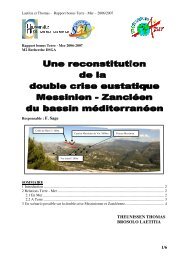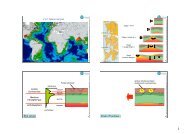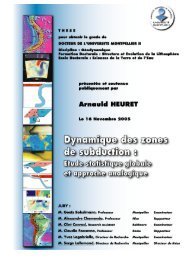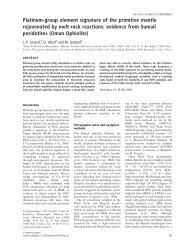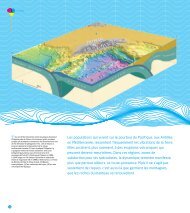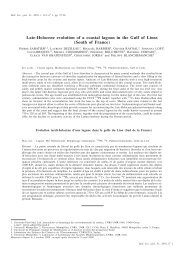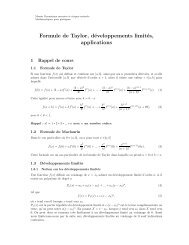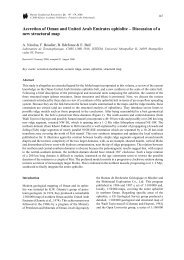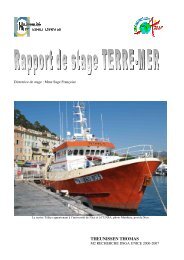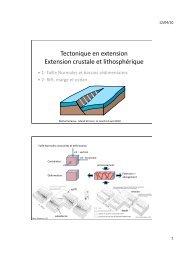Géochronologie U-Pb par ablation laser et ICP-MS (LA-ICP-MS ...
Géochronologie U-Pb par ablation laser et ICP-MS (LA-ICP-MS ...
Géochronologie U-Pb par ablation laser et ICP-MS (LA-ICP-MS ...
Create successful ePaper yourself
Turn your PDF publications into a flip-book with our unique Google optimized e-Paper software.
CHEMGE-15681; No of Pages 18<br />
ARTICLE IN PRESS<br />
Chemical Geology xxx (2009) xxx–xxx<br />
Contents lists available at ScienceDirect<br />
Chemical Geology<br />
journal homepage: www.elsevier.com/locate/chemgeo<br />
Geochemical and p<strong>et</strong>rographic evidence for magmatic impregnation in the oceanic<br />
lithosphere at Atlantis Massif, Mid-Atlantic Ridge (IODP Hole U1309D, 30°N)<br />
Marion Drouin a,1 , Marguerite Godard a, ⁎, Benoit Ildefonse a , Olivier Bruguier a , Carlos J. Garrido b<br />
a Géosciences Montpellier, CNRS & Université Montpellier 2, F-34095 Montpellier cedex5, France<br />
b Instituto Andaluz de Ciencias de la Tierra (IACT), CSIC & UGR, Facultad de Ciencias, Fuentenueva sn. 18002 Granada, Spain<br />
article<br />
info<br />
abstract<br />
Article history:<br />
Received 9 June 2008<br />
Received in revised form 22 December 2008<br />
Accepted 24 February 2009<br />
Available online xxxx<br />
Editor: D.B. Dingwell<br />
Keywords:<br />
Troctolite<br />
<strong>LA</strong>-<strong>ICP</strong>-<strong>MS</strong><br />
Olivine<br />
Integrated Ocean Drilling Program<br />
Mid-ocean ridge<br />
Impregnated mantle<br />
IODP Hole U1309D (Atlantis Massif, Mid-Atlantic Ridge 30°N) is the second deepest hole drilled into slow<br />
spread gabbroic lithosphere. It comprises 5.4% of olivine-rich troctolites (~N70% olivine), possibly the most<br />
primitive gabbroic rocks ever drilled at mid-ocean ridges. We present the result of an in situ trace element<br />
study carried out on a series of olivine-rich troctolites, and neighbouring troctolites and gabbros, from<br />
olivine-rich intervals in Hole U1309D. Olivine-rich troctolites display poikilitic textures; coarse-grained<br />
subhedral to medium-grained rounded olivine crystals are included into large undeformed clinopyroxene<br />
and plagioclase poikiloblasts. In contrast, gabbros and troctolites have irregularly seriate textures, with highly<br />
variable grain sizes, and locally poikilitic clinopyroxene oikocrysts in troctolites. Clinopyroxene is high Mg#<br />
augite (Mg# 87 in olivine-rich troctolites to 82 in gabbros), and plagioclase has anorthite contents ranging<br />
from 77 in olivine-rich troctolites to 68 in gabbros. Olivine has high forsterite contents (82–88 in olivine-rich<br />
troctolites, to 78–83 in gabbros) and is in Mg–Fe equilibrium with clinopyroxene. Clinopyroxene cores and<br />
plagioclase are depl<strong>et</strong>ed in trace elements (e.g., Yb cpx ~5–11×Chondrite), they are in equilibrium with the<br />
same MORB-type melt in all studied rock-types. These compositions are not consistent with the progressively<br />
more trace element enriched (evolved) compositions expected from olivine rich primitive products to gabbros in<br />
a MORB cumulate sequence. They indicate that clinopyroxene and plagioclase crystallized concurrently, after<br />
melts having the same trace element composition, consistent with crystallization in an open system with a<br />
buffered magma composition. The slight trace element enrichments and lower Cr contents observed in<br />
clinopyroxene rims and interstitial grains results from crystallization of late-stage differentiated melts, probably<br />
indicating the closure of the magmatic system. In contrast to clinopyroxene and plagioclase, olivine is not in<br />
equilibrium with MORB, but with a highly fractionated depl<strong>et</strong>ed melt, similar to that in equilibrium with<br />
refractory oceanic peridotites, thus possibly indicating a mantle origin. In addition, textural relationships suggest<br />
that olivine was in <strong>par</strong>t assimilated by the basaltic melts after which clinopyroxene and plagioclase crystallized<br />
(impregnation). These observations suggest a complex crystallization history in an open system involving<br />
impregnation by MORB-type melt(s) of an olivine-rich rock or mush. The documented magmatic processes<br />
suggest that olivine-rich troctolites were formed in a zone with large magmatic transfer and accumulation, similar<br />
to the mantle-crust transition zone documented in ophiolites and at fast spreading ridges.<br />
© 2009 Elsevier B.V. All rights reserved.<br />
1. Introduction<br />
Slow spreading ridges (full-spreading rate b50 mm/yr), such as the<br />
Mid Atlantic Ridge (MAR), represent about half of Earth's mid-ocean<br />
ridges. In contrast to the layered fast-spread crust (Penrose Conference<br />
<strong>par</strong>ticipants, 1972; Ildefonse <strong>et</strong> al., 2007b), slow-spread crust is highly<br />
h<strong>et</strong>erogeneous with, at least in some places, discr<strong>et</strong>e gabbroic bodies<br />
intruded into serpentinized peridotites (e.g., Lagabrielle and Cannat,<br />
⁎ Corresponding author.<br />
E-mail address: Marguerite.Godard@gm.univ-montp2.fr (M. Godard).<br />
1 Present address: Laboratoire Géosciences Reunion, Institut de Physique du Globe de<br />
Paris, Université de la Réunion, UMR 7154, CNRS, 15 avenue René Cassin, BP 7151, F-97715<br />
Saint Denis messag CEDEX 9, La Réunion, France.<br />
1990; Cannat, 1993, 1996; Canales <strong>et</strong> al., 2000; Carlson, 2001). Ocean<br />
Drilling has provided deep access to gabbroic rocks emplaced at depth<br />
in this type of h<strong>et</strong>erogeneous lithosphere in various oceanic core<br />
complexes (Ildefonse <strong>et</strong> al., 2007a).<br />
During IODP Expeditions 304 and 305 (Blackman <strong>et</strong> al., 2006;<br />
Ildefonse <strong>et</strong> al., 2006), a 1415.5 m deep hole was drilled at 30°N near<br />
the Mid-Atlantic Ridge (Fig.1). IODP Hole U1309D is the second deepest<br />
hole in slow-spread lithosphere, after ODP Hole 735B on the Southwest<br />
Indian Ridge (Dick <strong>et</strong> al., 2000). Hole U1309D is almost exclusively made<br />
of gabbroic rocks (Blackman <strong>et</strong> al., 2006). Com<strong>par</strong>ed to ODP Hole 735B<br />
and other drilled gabbroic series, IODP Hole U1309D gabbroic rocks<br />
comprise a relatively large proportion of olivine-rich lithologies. The<br />
most olivine rich ones (~N70%) were grouped as olivine-rich troctolites,<br />
and represent 5.4% of the rocks recovered at Hole U1309D (Blackman<br />
0009-2541/$ – see front matter © 2009 Elsevier B.V. All rights reserved.<br />
doi:10.1016/j.chemgeo.2009.02.013<br />
Please cite this article as: Drouin, M., <strong>et</strong> al., Geochemical and p<strong>et</strong>rographic evidence for magmatic impregnation in the oceanic lithosphere at<br />
Atlantis Massif, Mid-Atlantic Ridge (IODP Hole U1309D, 30°N), Chemical Geology (2009), doi:10.1016/j.chemgeo.2009.02.013


